F.2 Preface
In the thirty-
Yet across these three decades of Psychology there has also been a stability of purpose: to merge rigorous science with a broad human perspective that engages both mind and heart. We aim to offer a state-
We are enthusiastic about psychology and its applicability to our lives. Psychological science has the potential to expand our minds and enlarge our hearts. By studying and applying its tools, ideas, and insights, we can supplement our intuition with critical thinking, restrain our judgmentalism with compassion, and replace our illusions with understanding. By the time students complete this guided tour of psychology, they will also, we hope, have a deeper understanding of our moods and memories, about the reach of our unconscious, about how we flourish and struggle, about how we perceive our physical and social worlds, and about how our biology and culture in turn shape us. (See TABLES 1 and 2.)
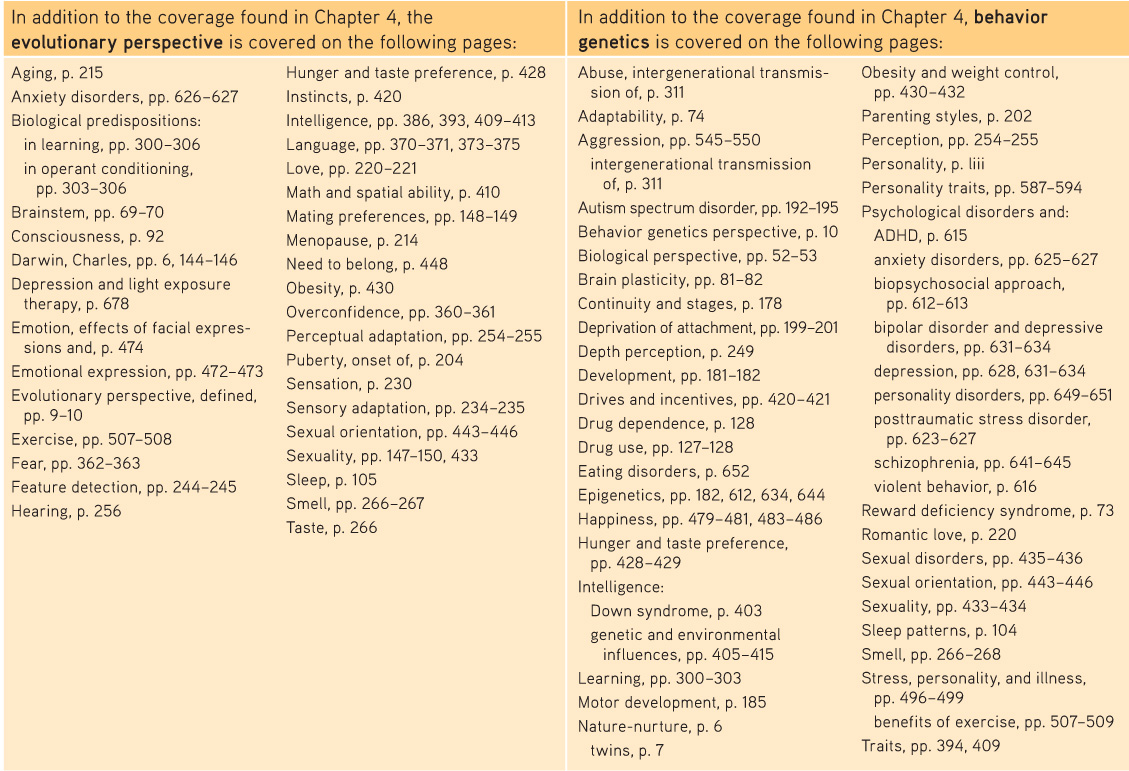
 Table 1
Table 1Evolutionary Psychology and Behavior Genetics
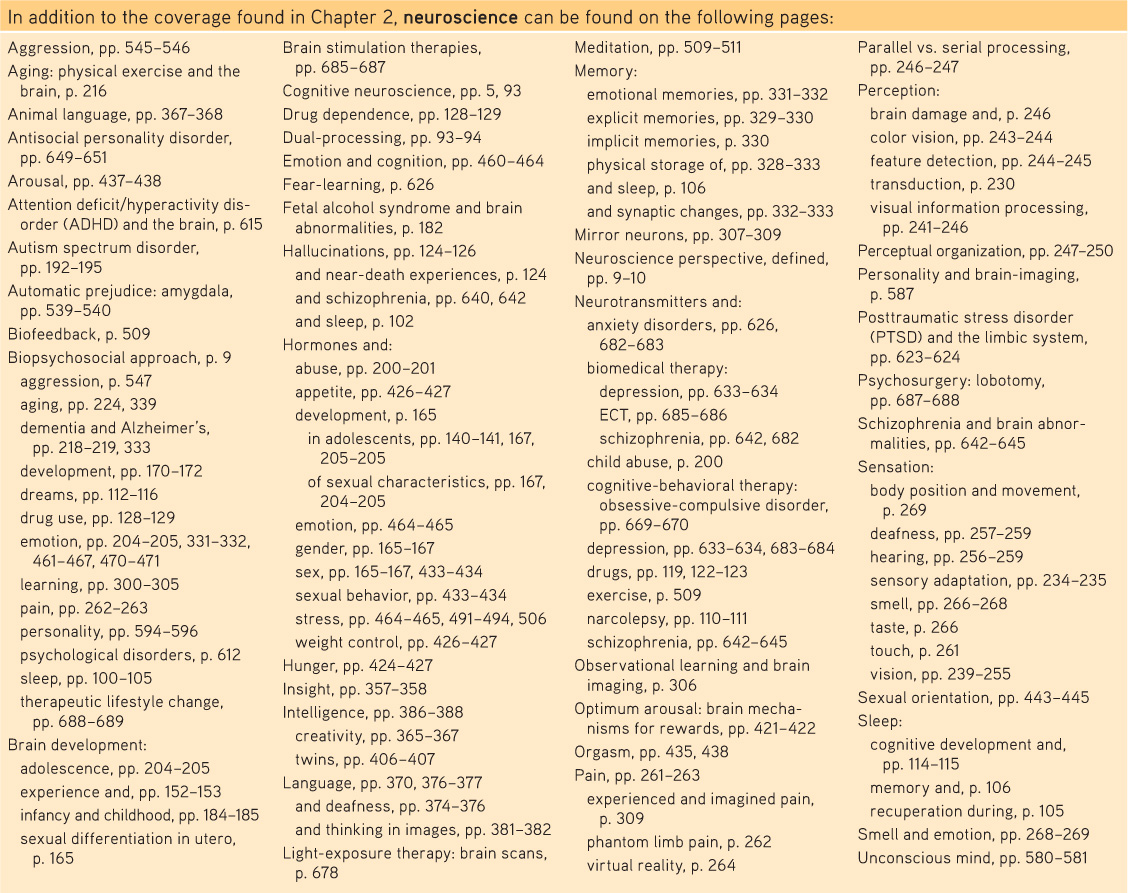
 Table 2
Table 2Neuroscience
Believing with Thoreau that “anything living is easily and naturally expressed in popular language,” we seek to communicate psychology’s scholarship with crisp narrative and vivid storytelling. We hope to tell psychology’s story in a way that is warmly personal as well as rigorously scientific. We love to reflect on connections between psychology and other realms, such as literature, philosophy, history, sports, religion, politics, and popular culture. And we love to provoke thought, to play with words, and to laugh. For his pioneering 1890 Principles of Psychology, William James sought “humor and pathos.” And so do we.
xvii
We are grateful for the privilege of assisting with the teaching of this mind-
Creating this book is a team sport. Like so many human achievements, it reflects a collective intelligence. Woodrow Wilson spoke for us: “I not only use all the brains I have, but all I can borrow.” The thousands of instructors and millions of students across the globe who have taught or studied with this book have contributed immensely to its development. Much of this contribution has occurred spontaneously, through correspondence and conversations. And we look forward to continuing feedback as we strive, over future editions, to create an ever better book and teaching package.
xviii
New Co-Author
For this new edition I [DM] welcome my new co-

What Else Is New in the Eleventh Edition?
This eleventh edition is the most carefully reworked and extensively updated of all the revisions to date. This new edition features improvements to the organization and presentation, especially to our system of supporting student learning and remembering. And we offer the exciting new How Would You Know? feature in LaunchPad, engaging students in the scientific process.
“How Would You Know?” Research Activities
These online activities, one per chapter, engage students in the scientific process, showing them how psychological research begins with a question, and how key decision points can alter the meaning and value of a psychological study. In a fun, interactive environment, students learn about important aspects of research design and interpretation. I [ND] have enjoyed taking the lead on this project and sharing my research experience and enthusiasm with students.
EXPANDED Study System Follows Best Practices From Learning and Memory Research
The improved learning system harnesses the testing effect, which documents the benefits of actively retrieving information through self-

 Figure 1
Figure 1How to learn and remember For a 5-
In addition, each section of text begins with numbered questions that establish learning objectives and direct student reading. A Review section follows each main section of text, providing students an opportunity to practice rehearsing what they’ve just learned. The Review offers self-
xix
Over 1200 New Research Citations
Our ongoing scrutiny of dozens of scientific periodicals and science news sources, enhanced by commissioned reviews and countless e-
Reorganized Chapters
In addition to the new study aids and updated coverage, we’ve introduced the following organizational changes:
- The Prologue, The Story of Psychology, now has a clearer organization and greater emphasis on modern approaches, including Cross-
Cultural and Gender Psychology, and new coverage of Positive Psychology (see also TABLE 3). 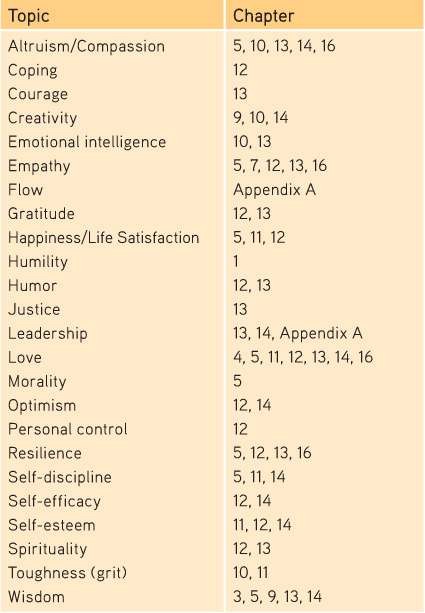
 Table 3
Table 3
Positive Psychology
- Chapter 1, Thinking Critically With Psychological Science, now offers greater emphasis on Psychology’s Research Ethics.
- Hypnosis is now covered in the Pain discussion in Chapter 6, Sensation and Perception (moved from Chapter 3).
- Chapter 11 has been re-
titled What Drives Us: Hunger, Sex, Friendship, and Achievement, with the Psychology at Work discussion moving to its own Appendix. - The Social Psychology chapter now follows the Personality chapter.
Dedicated Versions of Next-
This eleventh edition is accompanied by the new LaunchPad, with carefully crafted, prebuilt assignments, LearningCurve formative assessment activities, How Would You Know? activities, and Assess Your Strengths projects. This system also incorporates the full range of Worth’s psychology media products. (For details, see p. xxv and www.macmillanhighered.com/
For this new edition, you will see that we’ve offered callouts from the text pages to especially pertinent, helpful resources from LaunchPad. (See FIGURE 2 for a sample.)

 Figure 2
Figure 2Sample LaunchPad callout from Chapter 2.
 For an animated explanation of this process, visit LaunchPad’s Concept Practice: Action Potentials.
For an animated explanation of this process, visit LaunchPad’s Concept Practice: Action Potentials.
What Continues?
Eight Guiding Principles
Despite all the exciting changes, this new edition retains its predecessors’ voice, as well as much of the content and organization. It also retains the goals—
Facilitating the Learning Experience
- To teach critical thinking By presenting research as intellectual detective work, we illustrate an inquiring, analytical mind-
set. Whether students are studying development, cognition, or social behavior, they will become involved in, and see the rewards of, critical reasoning. Moreover, they will discover how an empirical approach can help them evaluate competing ideas and claims for highly publicized phenomena— ranging from ESP and alternative therapies to group differences in intelligence and repressed and recovered memories. - To integrate principles and applications Throughout—
by means of anecdotes, case histories, and the posing of hypothetical situations— we relate the findings of basic research to their applications and implications. Where psychology can illuminate pressing human issues— be they racism and sexism, health and happiness, or violence and war— we have not hesitated to shine its light. - To reinforce learning at every step Everyday examples and rhetorical questions encourage students to process the material actively. Concepts presented earlier are frequently applied, and reinforced. For instance, in Chapter 1, students learn that much of our information processing occurs outside of our conscious awareness. Ensuing chapters drive home this concept. Numbered Learning Objective Questions at the beginning of main sections, Retrieval Practice self-
tests throughout each chapter, Reviews at the end of each main text section, a marginal glossary, and Test Yourself questions at the end of each chapter help students learn and retain important concepts and terminology.
xx
Demonstrating the Science of Psychology
- To exemplify the process of inquiry We strive to show students not just the outcome of research, but how the research process works. Throughout, the book tries to excite the reader’s curiosity. It invites readers to imagine themselves as participants in classic experiments. Several chapters introduce research stories as mysteries that progressively unravel as one clue after another falls into place. Our new “How Would You Know?” activities in LaunchPad encourage students to think about research questions and how they may be studied effectively.
- To be as up-
to- date as possible Few things dampen students’ interest as quickly as the sense that they are reading stale news. While retaining psychology’s classic studies and concepts, we also present the discipline’s most important recent developments. In this edition, 867 references are dated 2012–2014. Likewise, new photos and everyday examples are drawn from today’s world. - To put facts in the service of concepts Our intention is not to fill students’ intellectual file drawers with facts, but to reveal psychology’s major concepts—
to teach students how to think, and to offer psychological ideas worth thinking about. In each chapter, we place emphasis on those concepts we hope students will carry with them long after they complete the course. Always, we try to follow Albert Einstein’s purported dictum that “everything should be made as simple as possible, but not simpler.” Learning Objective Questions and Retrieval Practice questions throughout each chapter help students learn and retain the key concepts.
Promoting Big Ideas and Broadened Horizons
- To enhance comprehension by providing continuity Many chapters have a significant issue or theme that links subtopics, forming a thread that ties ideas together. The Learning chapter conveys the idea that bold thinkers can serve as intellectual pioneers. The Thinking and Language chapter raises the issue of human rationality and irrationality. The Psychological Disorders chapter conveys empathy for, and understanding of, troubled lives. Other threads, such as cognitive neuroscience, dual processing, and cultural and gender diversity, weave throughout the whole book, and students hear a consistent voice.
- To convey respect for human unity and diversity Throughout the book, readers will see evidence of our human kinship—
our shared biological heritage, our common mechanisms of seeing and learning, hungering and feeling, loving and hating. They will also better understand the dimensions of our diversity— our individual diversity in development and aptitudes, temperament and personality, and disorder and health; and our cultural diversity in attitudes and expressive styles, child raising and care for the elderly, and life priorities.
xxi
Continually Improving Cultural and Gender Diversity Coverage
Discussion of the relevance of cultural and gender diversity begins on the first page and continues throughout the text.
This edition presents an even more thoroughly cross-
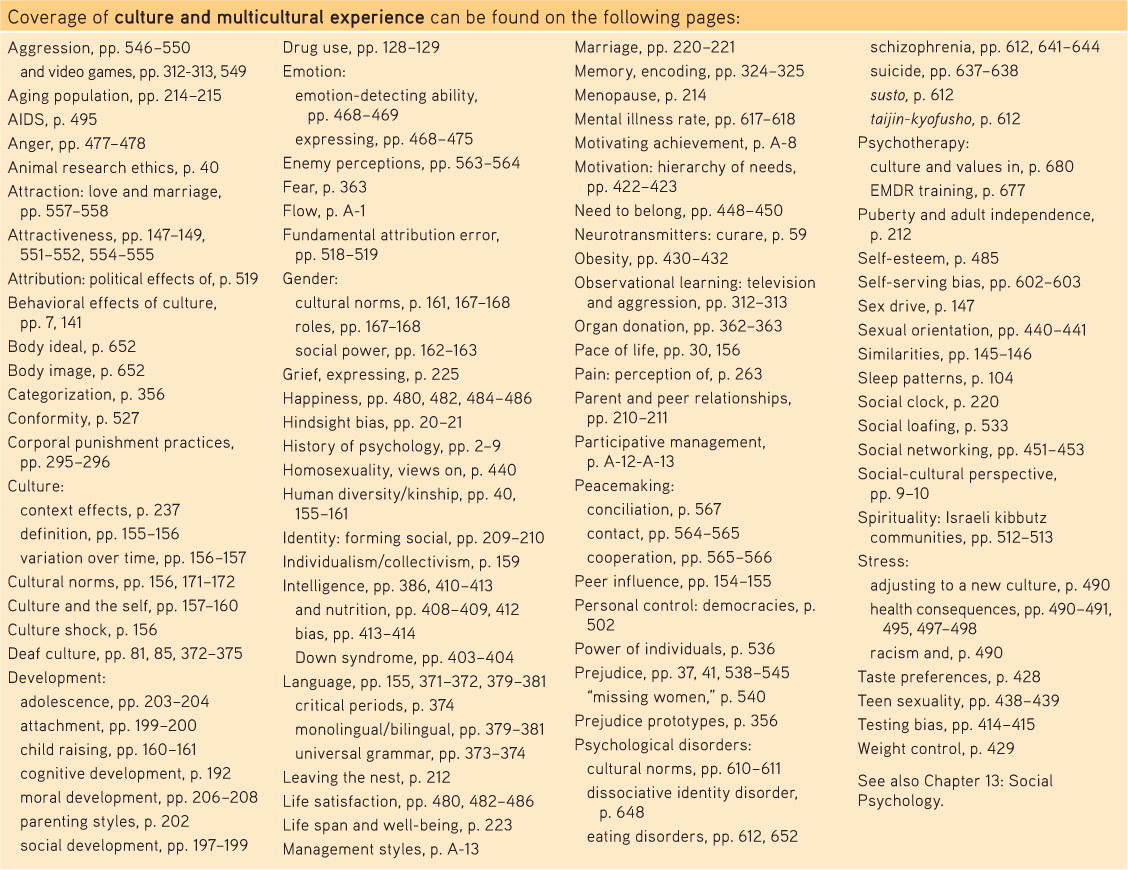
 Table 4
Table 4Culture and Multicultural Experience
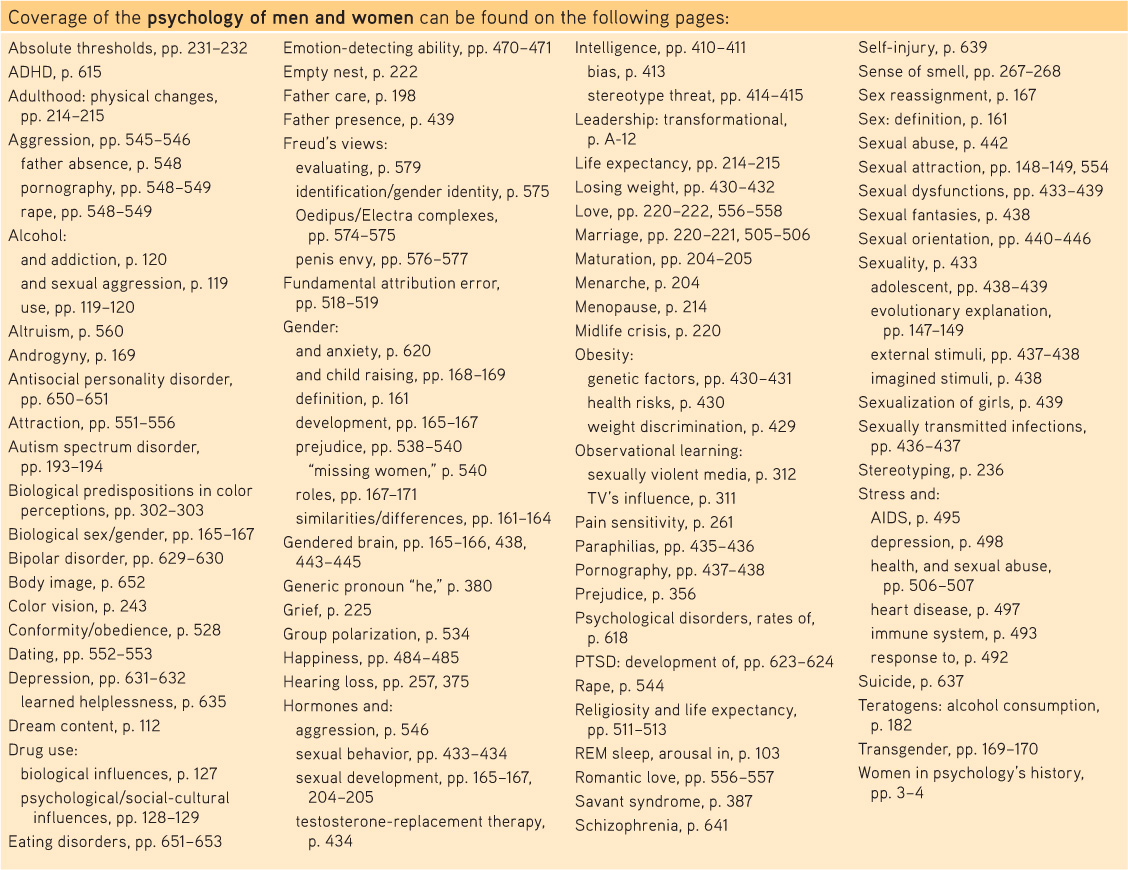
 Table 5
Table 5The Psychology of Men and Women
xxii
xxiii
Strong Critical Thinking Coverage
We love to write in a way that gets students thinking and keeps them active as they read, and we aim to introduce students to critical thinking throughout the book. Revised and more plentiful Learning Objective Questions at the beginning of text sections, and even more regular Retrieval Practice questions encourage critical reading to glean an understanding of important concepts. This eleventh edition also includes the following opportunities for students to learn or practice their critical thinking skills.
- Chapter 1, Thinking Critically With Psychological Science, introduces students to psychology’s research methods, emphasizing the fallacies of our everyday intuition and common sense and, thus, the need for psychological science. Critical thinking is introduced as a key term on page 24. The Statistical Reasoning discussion encourages students to “focus on thinking smarter by applying simple statistical principles to everyday reasoning” (pp. 36–
40). - “Thinking Critically About …” boxes are found throughout the book, modeling for students a critical approach to some key issues in psychology. For example, see “Thinking Critically About: Prenatal Testing to Predict Future Traits” (Chapter 4), or “Thinking Critically About: The Stigma of Introversion” (Chapter 14).
- Detective-
style stories throughout the narrative get students thinking critically about psychology’s key research questions. For example, in Chapter 15, we present the causes of schizophrenia piece by piece, showing students how researchers put the puzzle together. - “Apply this” and “Think about it” style discussions keep students active in their study. In Chapter 13, for example, students take the perspective of participants in a Solomon Asch conformity experiment, and later in one of Stanley Milgram’s obedience experiments. We’ve also asked students to join the fun by taking part in activities they can try along the way. For example, in Chapter 6, they try out a quick sensory adaptation activity. In Chapter 12, they try matching expressions to faces and test the effects of different facial expressions on themselves.
- Critical examinations of pop psychology spark interest and provide important lessons in thinking critically about everyday topics. For example, Chapter 6 offers an examination of ESP claims, and Chapter 8 examines claims of the repression of painful memories.
See TABLE 6 below for a complete list of this text’s coverage of critical thinking topics and Thinking Critically About boxes.
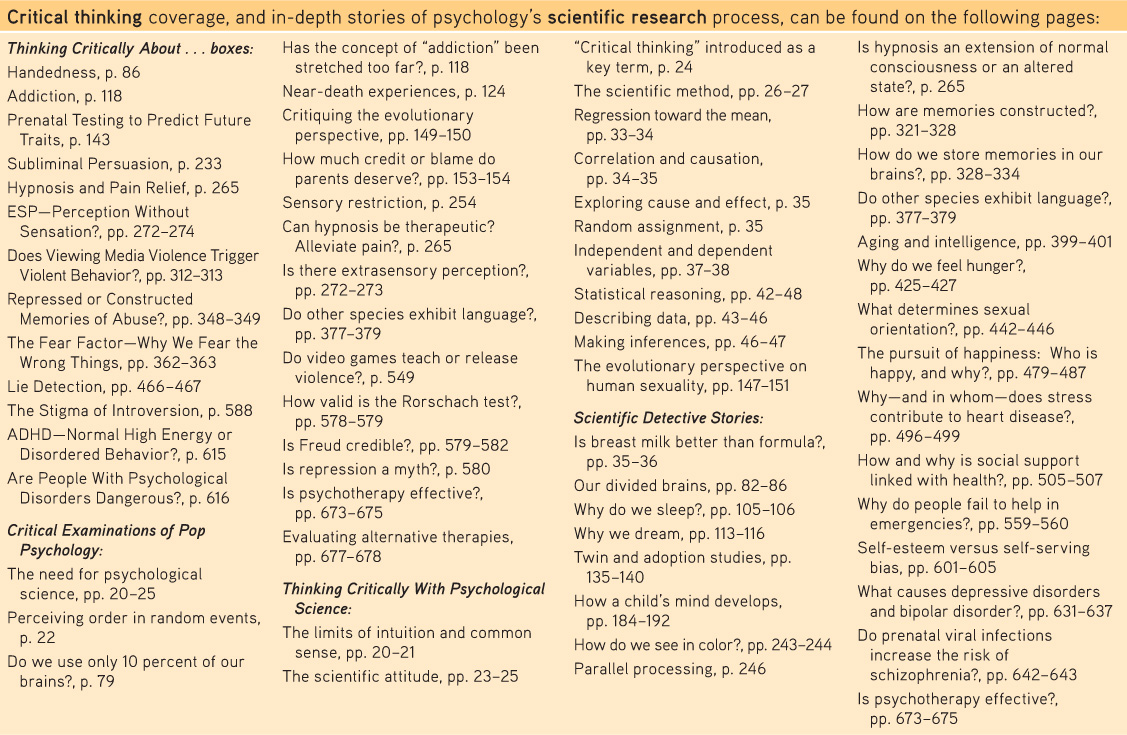
 Table 6
Table 6Critical Thinking and Research Emphasis
APA Assessment Tools
In 2011, the American Psychological Association (APA) approved the Principles for Quality Undergraduate Education in Psychology. These broad-
APA’s more specific 2013 Learning Goals and Outcomes, from their Guidelines for the Undergraduate Psychology Major, Version 2.0, were designed to gauge progress in students graduating with psychology majors. (See www.apa.org/
xxiv
Some instructors are eager to know whether a given text for the introductory course helps students get a good start at achieving these APA benchmarks. TABLE 7 outlines the way Psychology, eleventh edition, could help you to address the 2013 APA Learning Goals and Outcomes in your department.
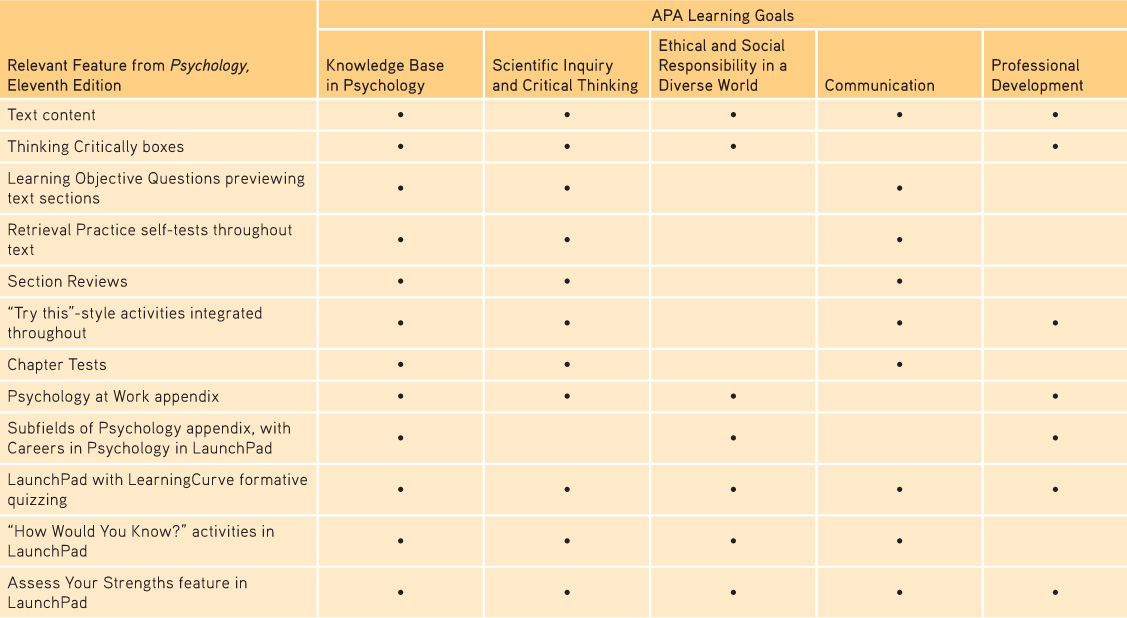
 Table 7
Table 7Psychology, Eleventh Edition, Corresponds to 2013 APA Learning Goals
In addition, an APA working group in 2013 drafted guidelines for Strengthening the Common Core of the Introductory Psychology Course (http:/
MCAT Now Includes Psychology
Starting in 2015, the Medical College Admission Test (MCAT) is devoting 25 percent of its questions to the “Psychological, Social, and Biological Foundations of Behavior,” with most of those questions coming from the psychological science taught in introductory psychology courses. From 1977 to 2014, the MCAT focused on biology, chemistry, and physics. Hereafter, reported the Preview Guide for MCAT 2015, the exam will also recognize “the importance of socio-
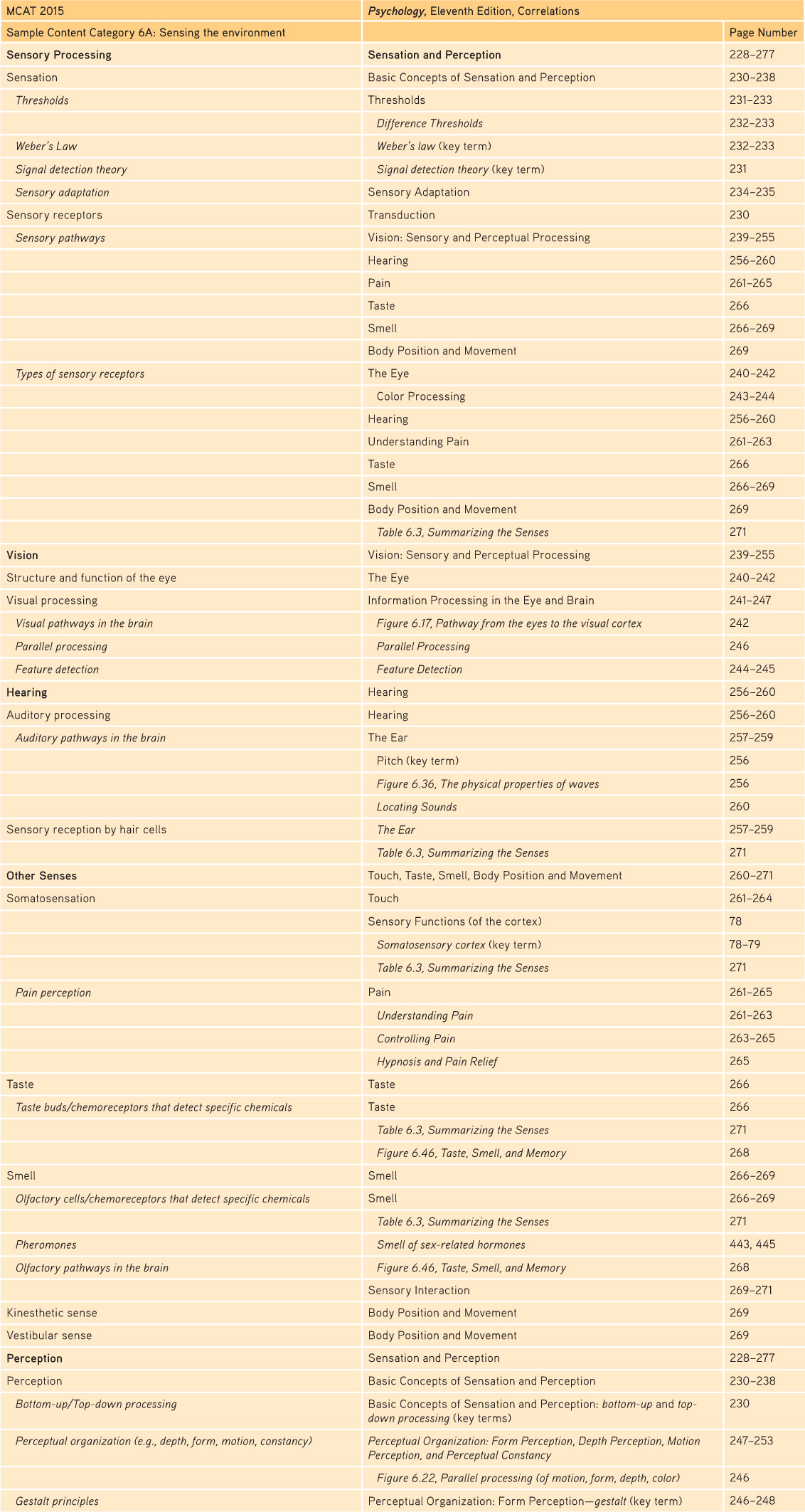
 Table 8
Table 8Sample MCAT Correlation With Psychology, Eleventh Edition
xxv
Next-Generation Multimedia
Psychology, eleventh edition, boasts impressive multimedia options. For more information about any of these choices, visit Worth Publishers’ online catalog at http:/
LaunchPad With LearningCurve Quizzing and “How Would You Know?” Activities
LaunchPad (www.macmillanhighered.com/
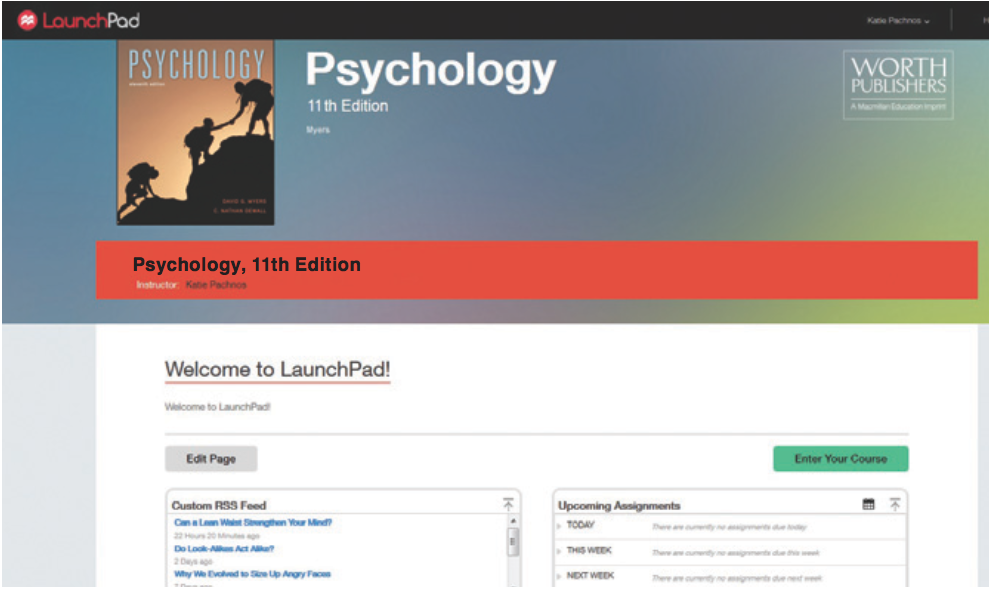
 Figure 3
Figure 3Sample from LaunchPad
xxvi
xxvii
- LearningCurve combines adaptive question selection, personalized study plans, immediate and valuable feedback, and state-
of- the- art question analysis reports. Based on the latest findings from learning and memory research, LearningCurve’s game- like nature keeps students engaged while helping them learn and remember key concepts. - New How Would You Know? activities offer a fun, interactive environment for learning about important aspects of research design and interpretation. Topics include “How Would You Know If Having Children Relates to Being Happier?”, “If a Cup of Coffee Can Warm Up Relationships?”, and “If People Can Learn to Reduce Anxiety?” Students work through the process of setting up an effective research design and interpreting results, and see first-
hand how decisions at each step affect outcomes. - With Assess Your Strengths activities, students may take inventories and questionnaires developed by researchers across psychological science. These self-
assessments allow students to apply psychology’s principles to their own lives and experiences. After taking each self- assessment, students will find additional information about the strength being tested (for example, personal growth initiative, sleep quality, empathizing/systemizing, intrinsic/extrinsic motivation, mindfulness, self- control, and hope), as well as tips for nurturing that strength more effectively in their own lives. - An Interactive e-
Book allows students to highlight, bookmark, and make their own notes, just as they would with a printed textbook. - Concept Practice, created by award-
winning multimedia author Thomas Ludwig (Hope College), helps students solidify their understanding of key concepts. With these in- depth tutorials, students explore a variety of important topics, often in an experimental context in the role of either researcher or participant. Tutorials combine animations, video, illustrations, and self- assessment. - PsychSim 6.0 Thoroughly re-
imagined and retooled for the mobile web, the new release of PsychSim by Thomas Ludwig uses interactive videos, charts, and simulations to immerse students in the world of psychological research, placing them in the role of scientist or participant in activities that highlight important concepts, processes, and experimental approaches. - Video Activities include more than 100 engaging video modules that instructors can easily assign and customize for student assessment. Videos cover classic experiments, current news footage, and cutting-
edge research, all of which are sure to spark discussion and encourage critical thinking. - Labs offer an interactive experience that fortifies the most important concepts and content of introductory psychology. In these activities, students participate in classic and contemporary experiments, generating real data and reviewing the broader implications of those findings. A virtual host makes this a truly interactive experience.
- The Scientific American Newsfeed delivers weekly articles, podcasts, and news briefs on the very latest developments in psychology from the first name in popular science journalism.
- Deep integration is available between LaunchPad products and Blackboard, Bright-
space by D2L, Canvas, and Moodle. These deep integrations offer educators single sign- on and gradebook sync now with auto- refresh. Also, these best- in- class integrations offer deep linking to all Macmillan digital content at the chapter and asset level, giving professors ultimate flexibility and customization capability within their LMS.
xxviii
Faculty Support and Student Resources
- Instructor’s Resources available in LaunchPad
- Lecture Guides available in LaunchPad
- Faculty Lounge—http:/
/psych.facultylounge.worthpublishers.com—(see FIGURE 4) is an online gathering place to find and share favorite teaching ideas and materials, including videos, animations, images, PowerPoint® slides and lectures, news stories, articles, web links, and lecture activities. Includes publisher as well as peer- provided resources— all faculty- reviewed for accuracy and quality. 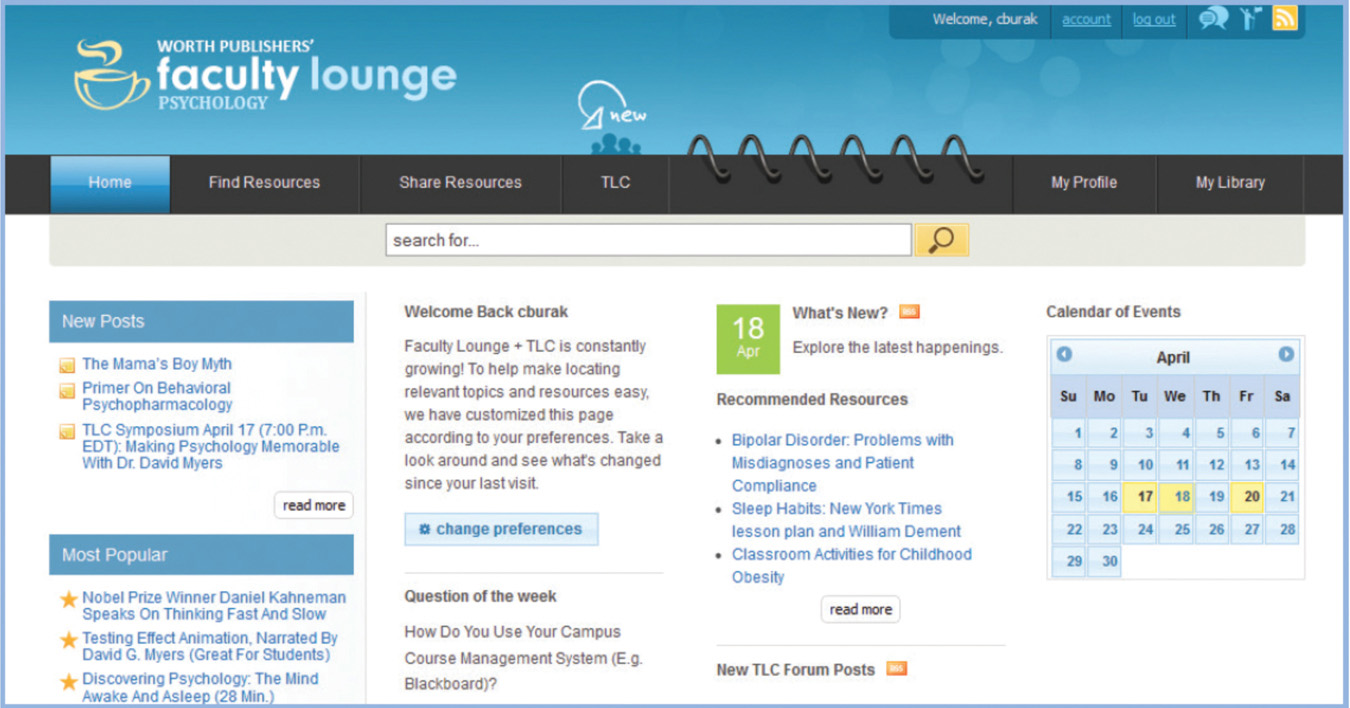
 Figure 4
Figure 4
Sample from our Faculty Lounge site (http://psych.facultylounge.worthpublishers.com) - Instructor’s Media Guide for Introductory Psychology
- Enhanced Course Management Solutions (including course cartridges)
- e-
Book in various available formats
xxix
Video and Presentation
- The Video Collection for Introductory Psychology is a complete collection, all in one place, of all of our video clips. The set is accompanied by its own Faculty Guide.
- Interactive Presentation Slides for Introductory Psychology is an extraordinary series of PowerPoint® lectures. This is a dynamic, yet easy-
to- use way to engage students during classroom presentations of core psychology topics. This collection provides opportunities for discussion and interaction, and includes an unprecedented number of embedded video clips and animations.
Assessment
- LearningCurve quizzing
- Diploma Test Banks, downloadable from LaunchPad and on our online catalog
- Chapter Quizzes in LaunchPad
- Clicker Question Presentation Slides now in PowerPoint®
- Study Guide
- Pursuing Human Strengths: A Positive Psychology Guide
- Critical Thinking Companion, Second Edition
- Psychology and the Real World: Essays Illustrating Fundamental Contributions to Society, second edition. This project of the FABBS Foundation brought together a virtual “Who’s Who” of contemporary psychological scientists to describe—
in clear, captivating ways— the research they have passionately pursued and what it means to the “real world.” Each contribution is an original essay written for this project.
xxx
In Appreciation
If it is true that “whoever walks with the wise becomes wise” then we are wiser for all the wisdom and advice received from colleagues. Aided by thousands of consultants and reviewers over the last two decades, this has become a better, more effective, more accurate book than two authors alone (these two authors, at least) could write. All of us together are smarter than any one of us.
Our indebtedness continues to each of the teacher-
Our gratitude extends to the colleagues who contributed criticism, corrections, and creative ideas related to the content, pedagogy, and format of this new edition and its teaching package. For their expertise and encouragement, and the gifts of their time to the teaching of psychology, we thank the reviewers and consultants listed here.
Aneeq Ahmad
Henderson State University
Dana Alston
South Suburban College
Nancy Armbruster
Mott Community College
Melanie Arpaio
Sussex County Community College
Kristen Begosh
University of Delaware
Barney Beins
Ithaca College
Susanne Biehle
DePauw University
Mark Brewer
Tacoma Community College
Lauren Brown
Mott Community College
Carolyn Burns
Washtenaw Community College
David Bush
Villanova University
Allison Butler
Bryant University
Shawn Charlton
University of Central Arkansas
Joy Crawford
Green River Community College
Pamela Danker
Blackburn College
Cheryl DeLeon
Purdue University North Central
Casey Dexter
Berry College
Mary Dolan
California State University, San Bernardino
Victor Duarte
North Idaho College
Robert DuBois
Waukesha County Technical College
Guadalupe Espinoza
California State University, Fullerton
Kristin Flora
Franklin College
Anastasia Ford
University of Florida
Alisha Francis
Northwest Missouri State University
Amber Garcia
The College of Wooster
Parastoo Ghazi
Suffolk University
Kimberly Glackin
Metropolitan Community College
Ethan Gologor
Medgar Evers College - The City
University of New York
Nicholas Greco
Columbia College - Lake County
Donnell Griffin
Davidson County Community College
Regan A. R. Gurung
University of Wisconsin - Green Bay
Robert Hoff
Mercyhurst University
Mia Holland
Bridgewater State College
Amy Holmes
Davidson County Community College
Lynn Ingram
University of North Carolina, Wilmington
Alisha Janowsky
University of Central Florida
Katherine Judge
Cleveland State University
Tracy Juliao
University of Michigan, Flint
Georgia Klamon-
Northeastern University
Kristina Klassen
North Idaho College
Reza Kormi-
Örebro University, Sweden
Frederick Kosinski, Jr.
Andrews University
Kenneth Leising
Texas Christian University
Fabio Leite
The Ohio State University
Stine Linden-
Bishop’s University
Mark Robert Ludorf
Stephen F. Austin State University
Mark Mach
Dodge City Community College
xxxi
Constance Manos-
Inver Hills Community College
Patsy McCall
Angelo State University
Megan McIlreavy
Coastal Carolina University
John McNeeley
Daytona State College
Antoinette Miller
Clayton State University
Deborah Moore
Central New Mexico Community College
Robin Morgan
Indiana University Southeast
Brenda Mueller
Otero Junior College
Morrie Mullins
Xavier University
Sara Neeves
Davidson County Community College
Marion Perlmutter
University of Michigan
Kathleen Peters
Eastern Florida State College
Mark Rittman
Cuyahoga Community College
Rebecca Roberts
Franklin College
Jeff Rudski
Muhlenberg College
Beth Schwartz
Randolph College
Rachel Schwartz
Valparaiso University
Zachary Shipstead
Arizona State University
Emily Stark
Minnesota State University, Mankato
Michael Stroud
Merrimack College
Jennifer Sumner
University of California, San Diego
Casey Trainor
Augustana College
Eugenia Valentine
Delgado Community College
Catherine Wehlburg
Texas Christian University
Nancie Wilson
Southwestern Community College
Linda Woolf
Webster University
Ivan Wu
Michigan State University
Robert Zimmerman
DePaul University
We were pleased to be supported by a 2012/2013 Content Advisory Board, which helped guide the development of this new edition of Psychology, eleventh edition, as well as our other introductory psychology titles. For their helpful input and support, we thank
Barbara Angleberger, Frederick Community College
Chip (Charles) Barker, Olympic College
Mimi Dumville, Raritan Valley Community College
Paula Frioli-
Deborah Garfin, Georgia State University
Karla Gingerich, Colorado State University
Toni Henderson, Langara College
Bernadette Jacobs, Santa Fe Community College
Mary Livingston, Louisiana Tech University
Molly Lynch, Northern Virginia Community College
Shelly Metz, Central New Mexico Community College
Jake Musgrove, Broward College - Central Campus
Robin Musselman, Lehigh Carbon Community College
Dana Narter, The University of Arizona
Lee Osterhout, University of Washington
Nicholas Schmitt, Heartland Community College
Christine Shea-
Brenda Shook, National University
Starlette Sinclair, Columbus State University
David Williams, Spartanburg Community College
Melissa (Liz) Wright, Northwest Vista College
xxxii
We also involved students in a survey to determine level of difficulty of key concepts. We are grateful to the 277 students from the following schools who participated:
Brevard Community College
Community College of Baltimore County
Florida International University
Millsaps College
Salt Lake Community College
And we appreciate the helpful guidance offered by the dozens of instructors who reviewed our new “How Would You Know?” feature in LaunchPad. (See www.macmillanhighered.com/
At Worth Publishers a host of people played key roles in creating this eleventh edition.
Although the information gathering is never ending, the formal planning began as the author-
Publishers Kevin Feyen and Rachel Losh have been valued team leaders, thanks to their dedication, creativity, and sensitivity. Kevin, now Vice-
Tracey Kuehn, Director of Editing, Design, and Media Production, displayed tireless tenacity, commitment, and impressive organization in leading Worth’s gifted artistic production team and coordinating editorial input throughout the production process. Project Editor Robert Errera and Production Manager Sarah Segal masterfully kept the book to its tight schedule, and Art Director Diana Blume skillfully directed creation of the beautiful new design and art program. Production Manager Stacey Alexander, along with Supplements Project Editor Julio Espin, did their usual excellent work of producing the supplements.
Christine Brune, chief editor for the last nine editions, is a wonder worker. She offers just the right mix of encouragement, gentle admonition, attention to detail, and passion for excellence. An author could not ask for more. Development Editor Nancy Fleming is one of those rare editors who is gifted both at “thinking big” about a chapter—
xxxiii
To achieve our goal of supporting the teaching of psychology, this teaching package not only must be authored, reviewed, edited, and produced, but also made available to teachers of psychology. For their exceptional success in doing that, our author team is grateful to Worth Publishers’ professional sales and marketing team. We are especially grateful to Executive Marketing Manager Kate Nurre, Marketing Manager Lindsay Johnson, and National Psychology and Economics Consultant emeritus Tom Kling, both for their tireless efforts to inform our teaching colleagues of our efforts to assist their teaching, and for the joy of working with them.
At Hope College, the supporting team members for this edition included Kathryn Brownson, who researched countless bits of information and proofed hundreds of pages. Kathryn has become a knowledgeable and sensitive adviser on many matters, and Sara Neevel has become our high-
Again, I [DM] gratefully acknowledge the editing assistance and mentoring of my writing coach, poet Jack Ridl, whose influence resides in the voice you will be hearing in the pages that follow. He, more than anyone, cultivated my delight in dancing with the language, and taught me to approach writing as a craft that shades into art. Likewise, I [ND] am grateful to my intellectual hero and mentor, Roy Baumeister, who taught me how to hone my writing and embrace the writing life.
After hearing countless dozens of people say that this book’s supplements have taken their teaching to a new level, we reflect on how fortunate we are to be a part of a team in which everyone has produced on-
Finally, our gratitude extends to the many students and instructors who have written to offer suggestions, or just an encouraging word. It is for them, and those about to begin their study of psychology, that we have done our best to introduce the field we love.
* * *
The day this book went to press was the day we started gathering information and ideas for the next edition. Your input will influence how this book continues to evolve. So, please, do share your thoughts.

Hope College
Holland, Michigan 49422-
www.davidmyers.org

University of Kentucky
Lexington, Kentucky 40506-
www.NathanDeWall.com
xxxiv